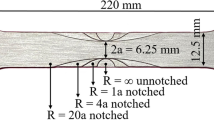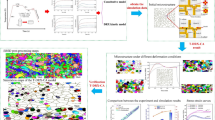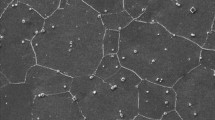Abstract
Automotive and construction industries demand for roll-formed high strength Dual-Phase steels due to their excellent structural performances and attractive appearances have increased dramatically over the last decade. However, their compromised ductility gives rise to problems and faces numerous manufacturing issues. These problems pertain to ductile fracture defect, which is often observed on tight radii during roll forming. The partial heating roll forming method is a recently proposed roll forming method alternative to the conventional cold roll forming method, aimed at reducing ductile fracture by partially heating only the bend areas. In this paper, the ductile fracture during the partial heating roll forming processes of DP980 high strength steel is evaluated by implementing the phenomenological Generalized Incremental Stress State Dependent Damage (GISSMO) model using the FE code LS-DYNA. To this aim, instability and fracture strains from the uniaxial, plane-strain, and shear tensile tests at different temperatures were evaluated. The basic tensile test results are in good agreement with the experimental results found in the literature. Subsequently, the instability and plastics strain at fracture from basic tensile tests were calibrated to numerical simulations of roll forming processes for ductile fracture predictions. Based on the results, the instability and fracture strain increase as the material’s temperature increases. Moreover, the ductile fracture investigation of DP980 during the cold roll forming process showed that fractures were observed on the profile's bend areas. However, no visible cracks were observed on the partial heated roll-formed profile.













Similar content being viewed by others
Abbreviations
- \(A, B,\) and,\(C\) :
-
Johnson–Cook material constants in Eq. 10
- \({A}_{0}\) :
-
Nominal cross-sectional area
- \({A}_{1}\; and \; {A}_{2}\) :
-
Effective plastic strains at fracture in shear and uniaxial tension
- \({A}_{eff}\) :
-
Effective cross-sectional area
- \(D\) :
-
Damage factor
- \(\dot{D}\) :
-
Incremental damage
- \({D}_{crit}\) :
-
Critical damage
- εcrit :
-
Effective plastic strain when instability occurs
- εp :
-
Accumulated plastic strain
- \({\varepsilon }_{f}\) :
-
Effective plastic strain at fracture
- \({\dot{\varepsilon }}_{p}\) :
-
Equivalent plastic strain increment
- F :
-
Instability function
- \(\dot{F}\) :
-
Incremental material's instability function
- \(m\) :
-
Fading exponent
- \(n\) :
-
Damage exponent
- \({\eta }_{0}\) :
-
Stress triaxiality in uniaxial tension
- η :
-
Stress triaxiality
- \({\upeta }_{avg}\) :
-
Average stress triaxiality
- \(\bar{\sigma }\) :
-
Damage uncoupled elements flow stress
- \({\upsigma }_{1}, {\upsigma }_{2}, {\mathrm{and\,\sigma }}_{3}\) :
-
Principal stresses
- \({\sigma }_{eff}\) :
-
Effective stress
- \({\sigma }_{H}\) :
-
Hydrostatic stress
- \({\sigma }_{true}\) :
-
True stress
- \({\sigma }_{updated}\) :
-
Damage coupled elements flow stress
- \({\upsigma }_{\mathrm{vm}}\) :
-
Von Mises stress
- \(T\) :
-
Forming temperature
- \({T}_{m}\) :
-
Melting temperature
- \({T}_{r}\) :
-
Room temperature
References
Bai Y, Wierzbicki T (2010) Application of extended Mohr-Coulomb criterion to ductile fracture. Int J Fract 161:1–20. https://doi.org/10.1007/s10704-009-9422-8
Bao Y, Wierzbicki T (2004) On fracture locus in the equivalent strain and stress triaxiality space. Int J Mech Sci 46:81–98. https://doi.org/10.1016/j.ijmecsci.2004.02.006
Bao Y, Wierzbicki T (2005) On the cut-off value of negative triaxiality for fracture. Eng Fract Mech 72:1049–1069. https://doi.org/10.1016/j.engfracmech.2004.07.011
Brnic J, Canadija M, Turkalj G et al (2009) Tool material behavior at elevated temperatures. Mater Manuf Process 24:758–762. https://doi.org/10.1080/10426910902809800
Deole AD, Barnett MR, Weiss M (2018) The numerical prediction of ductile fracture of martensitic steel in roll forming. Int J Solids Struct 144–145:20–31. https://doi.org/10.1016/j.ijsolstr.2018.04.011
Gurson AL (1977) Continuum theory of ductile rupture by void nucleation and growth. J Eng Mater Technol 99:2–15
Hallquist JO (2006) LS-DYNA Theory manual, Livermore Software Technology Corp
Halmos GT (2005) Roll forming handbook. CRC, New York
Han F, Wang Y, Wang ZL (2018) Mechanical bending property of ultra-high strength steel sheets IN roll forming process. Int J Precis Eng Manuf 19:1885–1893. https://doi.org/10.1007/s12541-018-0216-7
Johnson GR, Cook WH (1985) Fracture characteristics of three metals subjected to various strains, strain rates, temperatures and pressures. Eng Fract Mech 21:31–48. https://doi.org/10.1016/0013-7944(85)90052-9
Lee EH, Yang DY, Yoon JW, Yang WH (2015) Numerical modeling and analysis for forming process of dual-phase 980 steel exposed to infrared local heating. Int J Solids Struct 75–76:211–224. https://doi.org/10.1016/j.ijsolstr.2015.08.014
Lemaitre J (1985) A continuous damage mechanics model for ductile fracture. J Eng Mater Technol Trans ASME 107:83–89. https://doi.org/10.1115/1.3225775
Li Y, Luo M, Gerlach J, Wierzbicki T (2010) Prediction of shear-induced fracture in sheet metal forming. J Mater Process Technol 210:1858–1869. https://doi.org/10.1016/j.jmatprotec.2010.06.021
Lou Y, Huh H (2013) Journal of Materials Processing Technology Prediction of ductile fracture for advanced high strength steel with a new criterion: experiments and simulation. J Mater Process Tech 213:1284–1302. https://doi.org/10.1016/j.jmatprotec.2013.03.001
Lou Y, Huh H, Lim S, Pack K (2012) New ductile fracture criterion for prediction of fracture forming limit diagrams of sheet metals. Int J Solids Struct 49:3605–3615. https://doi.org/10.1016/j.ijsolstr.2012.02.016
McClintock FA (1968) A Criterion for Ductile Fracture by the Growth of Holes. ASME J Appl Mech 35:363–371
Neukamm F, Feucht M, Haufe A (2009) Considering damage history in crashworthiness simulations. 7th Eur LS-DYNA Conf
Ozturk F, Ece RE, Polat N, Koksal A (2010) Effect of warm temperature on springback compensation of titanium sheet. Mater Manuf Process 25:1021–1024. https://doi.org/10.1080/10426914.2010.492056
Pandre S, Morchhale A, Kotkunde N, Singh SK (2020) Influence of processing temperature on formability of thin-rolled DP590 steel sheet. Mater Manuf Process 35:901–909. https://doi.org/10.1080/10426914.2020.1743854
Rice JR, Tracey DM (1969) On the ductile enlargement of voids in triaxial stress fields*. J Mech Phys Solids 17:201–217. https://doi.org/10.1016/0022-5096(69)90033-7
Simpson N, Van Rooyen GT (2003) Corner cracking associated with the production of square tubing from low carbon ferritic stainless steel. J South African Inst Min Metall 103:641–644
Tvergaard V (1981) Influence of voids on shear band instabilities under plane strain conditions. Int J Fract 17:389–407. https://doi.org/10.1007/BF00036191
Tvergaard V, Needleman A (1984) Analysis of the cup-cone fracture in a round tensile bar. Acta Metall 32:157–169. https://doi.org/10.1016/0001-6160(84)90213-X
Wang H, Yan Y, Jia F, Han F (2016) Investigations of fracture on DP980 steel sheet in roll forming process. J Manuf Process 22:177–184. https://doi.org/10.1016/j.jmapro.2016.03.008
Xue L (2008) Constitutive modeling of void shearing effect in ductile fracture of porous materials. Eng Fract Mech 75:3343–3366. https://doi.org/10.1016/j.engfracmech.2007.07.022
Xue L (2007) Damage accumulation and fracture initiation in uncracked ductile solids subject to triaxial loading. Int J Solids Struct 44:5163–5181. https://doi.org/10.1016/j.ijsolstr.2006.12.026
Yao D, Cai L, Bao C (2016) A new fracture criterion for ductile materials based on a finite element aided testing method. Mater Sci Eng A 673:633–647. https://doi.org/10.1016/j.msea.2016.06.076
Zhang XW, Wen JF, Zhang XC et al (2019) Effects of the stress state on plastic deformation and ductile failure: Experiment and numerical simulation using a newly designed tension-shear specimen. Fatigue Fract Eng Mater Struct 42:2079–2092. https://doi.org/10.1111/ffe.13084
Author information
Authors and Affiliations
Corresponding author
Ethics declarations
Conflict of interest
The authors declare that they have no competing interests.
Additional information
Publisher's Note
Springer Nature remains neutral with regard to jurisdictional claims in published maps and institutional affiliations.
Rights and permissions
About this article
Cite this article
Mehari, Z.A., Han, J. Numerical prediction of ductile fracture during the partial heating roll forming process of DP980. Int J Fract 234, 97–112 (2022). https://doi.org/10.1007/s10704-021-00572-5
Received:
Accepted:
Published:
Issue Date:
DOI: https://doi.org/10.1007/s10704-021-00572-5




